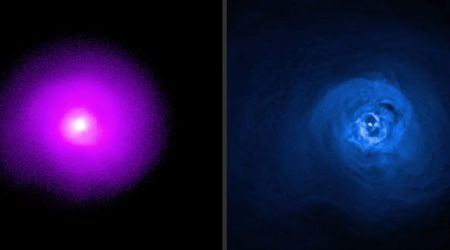NASA’s IXPE gives groundbreaking insight into rare pulsar's X-ray emissions, baffling scientists

A group of international astronomers has leveraged observations from NASA's Imaging X-ray Polarimetry Explorer (IXPE) to gain new insights into a rare type of pulsar, challenging existing theories about how these cosmic objects generate high-energy radiation. The findings shed light on the complex interaction between a spinning neutron star and its companion, per NASA.
✨ A cosmic lighthouse just revealed its secrets!
— NASA Marshall (@NASA_Marshall) July 15, 2025
Thanks to new observations from #NASAIXPE and other telescopes, scientists found that X-rays from the rare pulsar system J1023 do not come from the star itself, but the pulsar wind. 🌬️
READ MORE >> https://t.co/Zi4KMQKJJt pic.twitter.com/Cyz7viWU6R
The subject of the study is a unique binary system known as PSR J1023+0038, or J1023 for short, which consists of a rapidly rotating neutron star feeding off a less massive neighboring star. This neutron star is also a pulsar, emitting powerful beams of light from its magnetic poles like a lighthouse beacon. What makes J1023 so valuable to scientists is its ability to transition between two distinct states: an active phase where it consumes matter from its companion, and a dormant phase where it emits radio-wave pulsations. This behaviour has earned it the classification of a "transitional millisecond pulsar."

According to the lead author, Maria Cristina Baglio of the Italian National Institute of Astrophysics, transitional millisecond pulsars are "cosmic laboratories" that provide a unique opportunity to study how neutron stars evolve in binary systems. The core question for the research team was to pinpoint the origin of the system's X-rays. Previous models had suggested the X-rays came from the accretion disk, a swirling mass of gas and dust surrounding the neutron star.
However, the new findings, published in The Astrophysical Journal Letters, point to a different source: the pulsar wind. This chaotic stream of high-speed particles, gases, and magnetic fields from the popular was found to be the true generator of the X-rays as it collides with the accretion disk. To arrive at this conclusion, the researchers used IXPE, a satellite capable of measuring the polarization of X-rays in space.

By comparing these X-ray polarization measurements with optical light polarization data from the European Southern Observatory's Very Large Telescope (VLT) in Chile, they discovered that both wavelengths of light showed the same angle of polarization. “That finding is compelling evidence that a single, coherent physical mechanism underpins the light we observe,” stated co-lead author Francesco Coti Zelati of the Institute of Space Sciences in Barcelona, Spain.

This observation directly contradicts earlier theories and demonstrates that the pulsar wind, not the accretion disk, is the primary driver of the system's energy output. The discovery provides a critical piece of the puzzle in understanding particle accretion and accretion physics within these extraordinary cosmic systems. Researchers plan to continue studying transitional millisecond pulsars to further refine theoretical models and uncover more of the universe's secrets.
Pulsars are rapidly spinning neutron stars that emit focused beams of radiation. These beams are generated by powerful magnetic fields, which funnel jets of particles from the star's two magnetic poles. As the neutron star rotates, these energetic beams sweep through space, according to NASA. Much like a lighthouse beacon, we only detect a pulse of light when one of these beams sweeps across our line of sight. Since a pulsar's magnetic axis is often misaligned with its rotational axis, its beams appear to turn on and off from our perspective as the star spins, creating the regular, pulsating signals that give pulsars their name. Most observed neutron stars are a type of pulsar.









